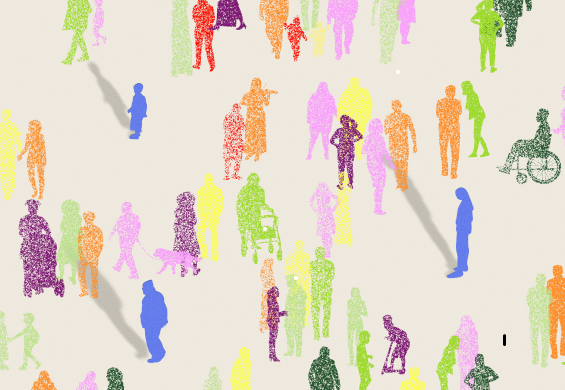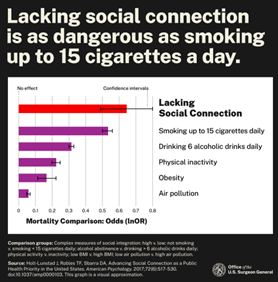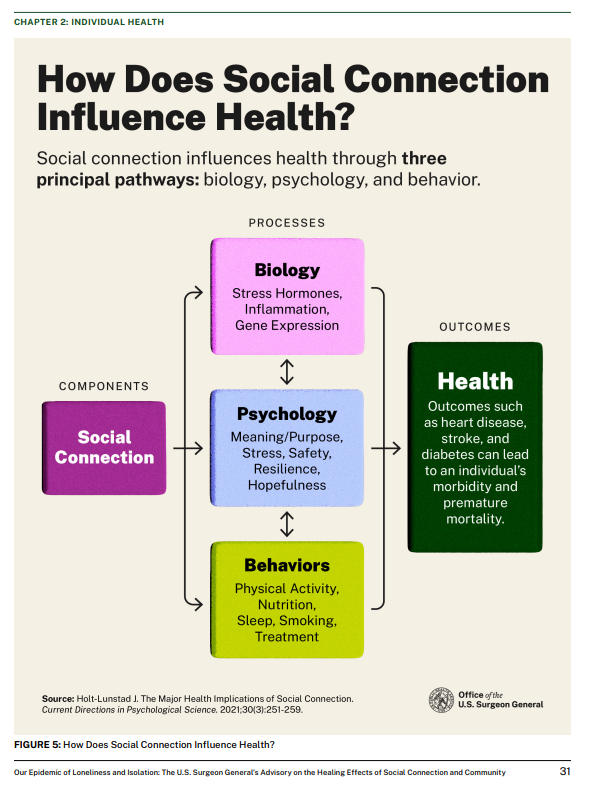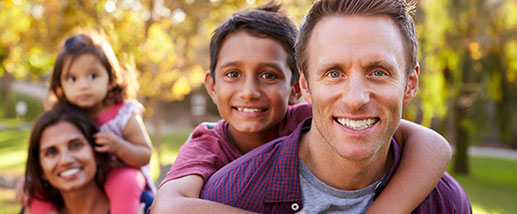Our Epidemic of Loneliness and Isolation
April 30, 2024
Categories: Behavioral & Mental Health, Community Health, Men's Health, Women's Health
In 2023, the Office of the U.S. Surgeon General published an 82-page advisory showing the profound consequences of loneliness and isolation.
“We have an opportunity, and an obligation, to make the same investments in addressing social connection that we have made in addressing tobacco use, obesity, and the addiction crisis,” said Vivek H. Murthy, MD, MBA; 19th and 21st Surgeon General of the United States; Vice Admiral, United States Public Health Service, in the introduction of this advisory. “This Surgeon General’s Advisory shows us how to build more connected lives and a more connected society.”
The importance of this study cannot be emphasized enough. “We are a social species,” said Carey Krause, DO, chief of Psychiatry, Trinity Health Grand Rapids. “Normal human behavior favors frequent interactions with our family and our ‘tribe’ throughout the day. The isolation people experienced with the COVID pandemic has led to significant social disruption and shows us how vulnerable we are to forces that disrupt our normal social interactions.”
What follows are direct quotes from the Surgeon General’s Advisory along with thoughts from Dr. Carey Krause and Dr. David Jasperse of Trinity Health Grand Rapids.
The Report’s Conclusions
Extensive scientific findings from a variety of disciplines, including epidemiology, neuroscience, medicine, psychology, and sociology, converge on the same conclusion: social connection is a significant predictor of longevity and better physical, cognitive, and mental health, while social isolation and loneliness are significant predictors of premature death and poor health.10,20,32,124
What is Social Connection?
Our relationships and interactions with family, friends, colleagues, and neighbors are just some of what create social connection.
Our connection with others and our community is also informed by our neighborhoods, digital environments, schools, and workplaces.
Social connection—the structure, function, and quality of our relationships with others—is a critical and underappreciated contributor to individual and population health, community safety, resilience, and prosperity.6,17,32-36 However, far too many Americans lack social connection in one or more ways, compromising these benefits and leading to poor health and other negative outcomes.
Key Data Social Connection Graph
-
Data across 148 studies, with an average of 7.5 years of follow-up, suggest that social connection increases the odds of survival by 50%.
-
Approximately half of U.S. adults report experiencing loneliness, with some of the highest rates among young adults.
-
The rate of loneliness among young adults has increased every year between 1976 and 2019.
-
In 1960, single-person households accounted for only 13% of all U.S. households. In 2022, that number more than doubled, to 29% of all households.
-
Lacking social connection can increase the risk for premature death as much as smoking up to 15 cigarettes a day.
Synthesis of data across 16 independent longitudinal studies shows poor social relationships (social isolation, poor social support, loneliness) were associated with a 29% increase in the risk of heart disease and a 32% increase in the risk of stroke.
-
The involvement and support of family members has been repeatedly shown to improve disease management and the health of people with type 1 diabetes and type 2 diabetes.
-
Chronic loneliness and social isolation can increase the risk of developing dementia by approximately 50% in older adults.
-
Loneliness and social isolation among children and adolescents increase the risk of depression and anxiety.
“These statistics are consistent with my clinical experience,” said David Jasperse, MD, Family Medicine, Primary Care Department Chair Grand Rapids.
Social Connection — A Fundamental Human Need
Social connection is a fundamental human need, as essential to survival as food, water, and shelter. Throughout history, our ability to rely on one another has been crucial to survival.
…we human beings are biologically wired for social connection. Our brains have adapted to expect proximity to others.51,52 Our distant ancestors relied on others to help them meet their basic needs.
Despite current advancements that now allow us to live without engaging with others (e.g., food delivery, automation, remote entertainment), our biological need to connect remains.
The mortality impact of being socially disconnected is similar to that caused by smoking up to 15 cigarettes a day,4 and even greater than that associated with obesity and physical inactivity. And the harmful consequences of a society that lacks social connection can be felt in our schools, workplaces, and civic organizations, where performance, productivity, and engagement are diminished.
The lack of social connection poses a significant risk for individual health and longevity. Loneliness and social isolation increase the risk for premature death by 26% and 29% respectively.37
Furthermore, it is associated with increased risk for anxiety, depression,39 and dementia.40,41 Additionally, the lack of social connection may increase susceptibility to viruses and respiratory illness.4
Adults across the globe rate their social relationships, particularly with family and close friends, as the most important source of meaning, purpose, and motivation in their lives.
Trends in Social Connections
Social networks are getting smaller, and levels of social participation are declining distinct from whether individuals report that they are lonely.
The number of close friendships has also declined over several decades.
Family size and marriage rates have been in steady decline for decades.70
Although the concept of community has evolved over time, many traditional indicators of community involvement, including with religious groups, clubs, and labor unions, show declining trends in the United States since at least the 1970s.12,71 In 2018, only 16% of Americans reported that they felt very attached to their local community.72
“In our culture, we think of wealth only in terms of money, but in the ups and downs of real life, a dependable social network is invaluable,” said Dr. Jasperse. “We need to take the same view of our social network that we do of our money or our health—it takes an investment mindset. It takes regular intentional investments of time and energy into the people around us to gradually build those meaningful connections.”
Groups at Higher Risk for Social Disconnection
…Studies find the highest prevalence for loneliness and isolation among people with poor physical or mental health, disabilities, financial insecurity, those who live alone, single parents, as well as younger and older populations.1
Additional at-risk groups may include individuals from ethnic and racial minority groups, LGBTQ+ individuals, rural residents, victims of domestic violence, and those who experience discrimination or marginalization.
Dr. Jasperse, who serves patients a Clínica Santa Maria in Grand Rapids, is concerned about these high-risk groups. “We need to be extra intentional about those most vulnerable in society. Many of my patients feel unable to engage in their community because of language, culture, or legal status. Many of the most vulnerable around us are so far on the margins that we never even see or notice them.”
Impacts of Technology on Social Connection
Several examples of benefits include technology that can foster connection by providing opportunities to stay in touch with friends and family, offering other routes for social participation for those with disabilities, and creating opportunities to find community, especially for those from marginalized groups.97,106-108
Several examples of harms include technology that displaces in-person engagement, monopolizes our attention, reduces the quality of our interactions, and even diminishes our self-esteem.97,109,110 This can lead to greater loneliness, fear of missing out, conflict, and reduced social connection.
Dr. Krause offers cautions about the effects of technology. “Remote work and even telehealth visits may be convenient and efficient, but we need to be cautious about giving up some of our few remaining face-to-face opportunities.
“Social media discourages actual conversation and interaction, allowing people to retreat into more extreme viewpoints while stimulating their anger and frustration with people who don’t agree.”
From the Surgeon General
Loneliness and isolation represent profound threats to our health and well-being. But we have the power to respond. By taking small steps every day to strengthen our relationships, and by supporting community efforts to rebuild social connection, we can rise to meet this moment together. We can build lives and communities that are healthier and happier. And we can ensure our country and the world are better poised than ever to take on the challenges that lay ahead.
What You Can Do
“The Surgeon General’s report focuses on things larger agencies can do to combat social isolation. But we can do things on our own, as well,” said Dr. Krause.
“Organize or attend a block party on your street. Join a committee at church. Bring bagels to work. Make a point to say hello to your neighbor when you see them outside. And listen to another point of view. Even if you don’t agree, you have done something to improve someone else’s sense of feeling valued.”
The Surgeon General’s Advisory on the Healing Effects of Social Connection and Community was prepared by the Office of the Surgeon General with valuable contributions from partners across the U.S. Government and external reviewers, and it was published in 2023.
To learn about the services offered at Trinity Health Michigan, visit TrinityHealthMichigan.org/MentalHealth.




